Helping industries achieve modern wastewater management standards
By Andrew Yanjiao Xie
Established techniques for monitoring total residual oxidants in wastewater suffer from several performance limitations. The latest ion selective electrode technology offers a more accurate, sensitive and robust solution for ensuring regulatory compliance.
The measurement of total residual oxidants (TROs) in discharged water is a critical regulatory requirement across a broad range of industries such as marine, offshore and onshore wastewater management operations. The hazards associated with the release of biocides in effluent water into the environment can have a drastic effect on marine life. For example, bromine- and chlorine-based biocides are widely used to control biological growth in many industrial operations, including cooling water and wastewater systems. Similarly, biocides are also employed in the shipping industry for the treatment of ballast water to control the spread of invasive species between ports.
Careful process control is necessary to ensure biocide dosing levels are sufficiently high to provide effective and cost-efficient prevention of biological growth while assuring levels of TROs in effluent water are safely reduced prior to discharge to comply with environmental regulatory limits. Without effective monitoring and treatment, biocides released into the environment can cause serious harm to aquatic wildlife. With global guidelines for wastewater management becoming increasingly stringent, industries need powerful and reliable TRO monitoring technologies that perform in line with regulatory requirements across the entire spectrum of water management standards.
TRO Measurement Challenges
A wide range of technologies are available for the measurement of TRO levels in wastewater, with the most common being colorimetric and amperometric detection methods. Colorimetric techniques, which are based on the reaction of the halogen with N,N-diethyl-1,4-phenylenediamine sulfate (DPD) to form colored products, are widely used for the analysis of residual chlorine and other chlorine oxidants. Alternatively, amperometric methods such as chlorine sensors can be used to measure the change in current associated with specific chemical reactions.
However, each of these techniques has its own limitations, and implementing online TRO measurement technologies that can tolerate a broad range of potential interferences and support measurement across a variety of water matrices has traditionally proven challenging.
The performance of DPD colorimetric methods can be affected by a wide range of suspended and dissolved materials commonly found in wastewater samples, which can interfere with measurements and cause sensor readings to drift. Additionally, colorimetric DPD methods are less sensitive than other methods and suffer from large measurement errors at low parts per billion (ppb) TRO levels, which can be exacerbated by discoloration in the DPD reagent over time, undermining the accuracy of measurements. The need for batch monitoring of TRO levels is another major limitation of this method compared to continuous measurement techniques.
The accuracy of amperometric sensor technologies suffer from pH and flow variations. In addition, they employ membrane electrodes that can become clogged by particulates and microbial films, which can result in measurement drift and require cleaning and recalibration. As wastewater installations are often located in difficult-to-access locations, performing regular recalibration and maintenance is time-consuming and resource intensive.
In some cases, oxidation-reduction potential (ORP) sensors are used as a surrogate to indicate disinfection levels, but ORP sensors do not provide direct chlorine or TRO readings and suffer from slow response rates.
With tighter standards for wastewater management being implemented around the world, more robust and reliable technologies are required to deliver accurate TRO measurements efficiently.
TRO Measurement with Ion Selective Electrode Technology
Recent improvements in electrochemistry technologies are helping industries meet modern wastewater management standards across the entire spectrum of water monitoring applications. The latest TRO analyzers based on ion selective electrode (ISE) systems are delivering highly accurate, precise and sensitive measurements across a broad range of water matrices, including cooling water, sea water and wastewater.
Thanks to their advanced design, the latest ISE systems can measure TRO levels with an accuracy of less than 10 ppb error. This represents a significant improvement over DPD colorimetric methods that can be impacted by wastewater turbidity. Additionally, the enhanced sensitivity of some ISE systems enables detection limits of 1 ppb to be reached. By contrast, DPD colorimetric methods are typically only able to achieve detection limits of around 30 ppb.
Figure 1 shows a continuous reading of total chlorine in the cooling water of a power plant treated with sodium hypochlorite over a six-week period, which was measured using an ISE-based online TRO analyzer. Total chlorine levels in collected water samples were determined by a laboratory amperometric titration and DPD colorimetric methods are also shown. The results highlight the excellent agreement between the data obtained by the ISE method and amperometric titration method, highlighting the accuracy of ISE technique. This contrasts with the poor agreement between the amperometric titration and DPD colorimetric method data, which reveals measurement errors of up to 1.2 parts per million (ppm) using the colorimetric technique. Factors such as water color and turbidity can have a significant impact on the accuracy of colorimetric measurements but do not impact the readings obtained by ISE methods.
TRO measurements obtained by ISE methods also compare favorably to those made using ORP sensors. Figure 2 highlights the excellent agreement between power plant cooling water total chlorine readings taken by ISE and amperometric methods. This compares to the poor correlation between total chlorine measurements obtained using an amperometric chlorine sensor and an ORP sensor. Taken together, these results highlight how TRO analyzers based on ISE technology can offer more accurate control of biocide dosing and wastewater management than both DPD colorimetric and ORP methods.
Reducing Operational Costs and Maintenance Requirements
Improvements in the functionality and robustness of modern ISE systems are also helping to reduce the operational costs associated with wastewater monitoring. Automated ISE systems that provide on-demand TRO measurement can minimize reagent consumption and requirements for operator intervention by providing the option to initiate analysis only when sample flow is present, or only when biocide is being dosed into the sample. If no sample flow is present, these analyzers will proceed into a stand-by mode and stop any reagent delivery, leading to a reduction in reagent consumption. The ISE systems will also provide analysis on a continuous basis or at regular intervals, depending on the needs of the user.
Other design improvements are reducing maintenance requirements and the costs associated with ensuring compliance with wastewater management standards. ISE systems with self-cleaning cell designs are minimizing costly instrument downtime by actively preventing biological and chemical fouling. Similarly, improvements in sensor lifetime are extending the interval between system recalibration checks, and significantly reducing or eliminating maintenance requirements. Moreover, as ISE systems are unaffected by water coloration and turbidity, and do not use membranes that can be blocked, they are able to significantly reduce instrument drift. Some of the latest ISE-based TRO analyzers demonstrate less than 5 percent change in measurement accuracy over 180 days, a significant improvement over the weekly or daily maintenance required for other online measurement technologies.
Conclusion
With wastewater management standards becoming increasingly stringent, industries working across the full range of effluent water monitoring applications require robust and reliable TRO measurement technologies to ensure comprehensive regulatory compliance. Advances in ISE electrochemistry and instrument design in modern TRO analyzers are delivering more accurate and sensitive measurements while helping to reduce the operational costs and maintenance requirements associated with wastewater process control. IWW
About the Author: Andrew Yanjiao Xie is a senior R&D manager at Thermo Fisher Scientific. Throughout his career, he has led the development of water treatment chemistries, analyzers and automatic control solutions. He has published several journal and conference papers in the field of water treatment and analysis. He conducted water treatment research while earning his Ph.D. at Washington University in St. Louis.



